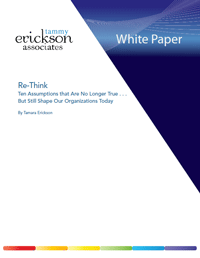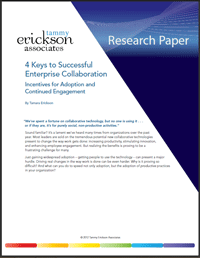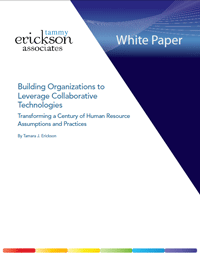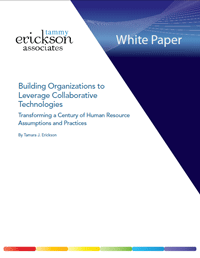Speaking

Many groups are looking for a way to bring the latest trends and issues affecting talent, innovation and intelligent organizations into focus – and to gain confidence and consensus for action.
My speeches and workshops are designed to do just that. With humor – and a clear discussion of the interplay among shifting attitudes, new technologies, changing demographics, and the latest understanding of engagement, collaboration and innovation – I help you “turn on the light bulb” within your group and, at the appropriate time, work through the ideas and approaches best suited to meet your organization’s shifting needs.
All my sessions are customized to the specific needs and interests of your group and can be done as either a keynote lecture of 60-90 minutes or an interactive workshop of 3-6 hours. For workshops, I have developed a number of popular group exercises designed to encourage wide-spread participation, learning, and application.
Here are the most frequently requested topics for my speaking engagements and workshops today.
New Leaders Wanted: How to Fix the Broken Leadership Model
The leadership model is broken – and an entire generation of potential leaders is on the verge of falling through the cracks. Today’s organizations simply aren’t suited to thrive through today’s challenges, says Tammy Erickson, an authority on the changing workforce and generations at work. But to future-proof business, change needs to start at the top.
A cohort of Generation X (and soon to be Y) is poised to take the helm as Baby Boomers finally let go of the reigns and move on to their second careers. Yet, Xers are opting out; they simply don’t want to buy into or be part of the organization of old, Erickson explains. Boomers, who have been firmly in charge for several decades, are rule followers who set, abide by, and measure against standards. And that just doesn’t work for Generation X who simply sees the business world – and how it’s run – very differently. They thrive amidst uncertainty, are not afraid to experiment and change direction, and crave broad perspective bigger than themselves.
“It’s all about intelligence and how it’s leveraged,” says Erickson. “Organizations and their leaders need to focus on creating context – not structure – that empowers smart people with great ideas to make meaningful contributions.”
To do so, leaders must learn how to:
- Wire their organization to create the right connections and networks
- Ask great questions and accept that they don’t always have all the answers
- Underscore meaning, focusing on matter over money
- Eliminate bias to get beyond antiquated assumptions in the way of new and better approaches
These needs – and the leadership skills to address them – are exactly what Erickson, an executive fellow in organizational behavior at London Business School, homed in on as she designed a new executive education program. The program, which will launch this fall, ties together all of these new ideals to help leaders effectively bring their business, and their own leadership style, into the future.
The leadership mindset must evolve, confront and embrace new realities of how work “works,” she urges. Or else the business world risks missing out on not only visionary talent, but much needed opportunities to make a difference and impact the world.
Leading a Multi-Generational Workforce
Four generations are working together in today’s workplace—and a fifth is on the way. Each brings unique assumptions to the job. As a result, events in the workplace are often interpreted differently by individuals in different generations. What may seem like good news to a Boomer might well be an unsettling and unwelcome development to a member of Generation X. Things that members of Gen Y love often seem unappealing or frivolous to those in older generations.
Generational perspectives form because many of our most powerful and lasting beliefs are shaped when we are teenagers, when we first shift our focus from tangible objects and begin to wrestle with the values and ideas in the world around us. What we see and hear—and the conclusions we draw—influence for our lifetimes what we value, how we measure success, whom we trust, and the priorities we set for our own lives, including the role work will play within it. Because members of a generation share some (but not, of course, all) of the same experiences, they tend to form some common perspectives.
Today it’s increasingly important to create a culture that is welcoming and engaging for talented individuals of all ages. Based on years of in-depth research and three books on generations in the workforce, Tammy Erickson helps audiences understand the underlying evolution of the assumptions each generation brings to work, with humor, empathy and enormous insight. Contributing rich data and unparalleled research with her optimistic point of view, Tammy offers practical strategies and actionable insights so that audiences of all ages will better understand each other.
Reactions from participants in Tammy’s sessions consistently rate hers as some of the most powerful insights into the generations they’ve ever heard, affecting not-only their future work relationships, but lending new understanding into family dynamics. “I’ve heard people speak about the generations before, but never anything like this!” “Thank you for your life-changing keynote.”
Global Generations
Geography significantly influences the formation of generational beliefs and behavior. Each country’s unique social, political, and economic events shape specific views and attitudes among today’s adults. Understanding these country-to-country differences is critical to creating employment deals that attract and retain the best employees in each geographic area. Western generational models cannot be applied broadly to a global workforce.
Tammy’s research has extended to the generations in a number of specific countries around the world, including the four BRIC nations, as well as countries in Europe and the Middle East. She will work with you to develop a customized session, focusing on the areas of the world that are most important to your business – or provide an overview of the similarities and differences within one generation around the globe.
Understanding individuals’ backgrounds and resultant perspectives or mental models both within generations and across geographies helps leaders grapple with the diversity, challenges, and potential of a global workforce. Better understanding leads to greater empathy for the “other guy’s” point of view and, ultimately, provides the foundation for more effective and efficient talent management practices.
Get Ready for the Next Wave: The Re-Generation
The next demographic wave is almost ready to hit the shore. Children who are 15-and-under today are almost certainly not members of Generation Y. They’ve been influenced by a very different set of global events than those that shaped the ideas and preferences of people in their late teens and 20s today.
Today’s children have been forming their mental maps of the future at a time when our national and global optimism has been doused with the cold water realization that we are facing significant, seemingly intractable problems on multiple fronts. The inconvenient truths of the past half century – precarious global finances, resource constraints, shifting economic power, and environmental degradation – are settling around our shoulders, and these early teens are not unaware of these issues or their complexity. This generation’s mental map is based on a world with finite limits and no easy answers.
What is this new generation, soon to be the fifth generation in many workplaces, all about? What do they value and how might they shape both the future of work and of the marketplace? Tammy’s newest research, the subject of a forthcoming book, brings the “Re-Generation” into sharp focus, with insights for employers, marketers, educators . . . and parents.
Ten Assumptions that Are No Longer True . . . But Still Shape Our Organizations Today
Today’s organizations are ripe for change. Over the next several decades, we’ll see very different business entities take their place.
Why? Because today’s organizations were designed in response to conditions that no longer exist. They are predicated on a set of underlying assumptions that most of us quickly recognize are not valid today. Do you still think loyal behavior at work will lead to a lifetime of protection and care from the corporation? Of course not. But many of our cherished talent management practices, from pension plans to perquisites, like vacation, that are based on tenure, are holdovers from the days when this old assumption rang true.
There are many new business realities that we haven’t yet translated into our management practices and organizational designs. It’s time to question which practices still make sense and whether there are new options, better suited to today.
In this provocative and interactive session based on a forth-coming book, Tammy will list ten assumptions that underpin organizations today. All have major implications for the way we manage talent and run organizations. None are true today. She’ll leave participants looking at their organizations – and themselves – through a new lens.
What Does It Mean to Work Here? A Signature Experience for Extraordinary Engagement
A highly engaged workforce has never been more important. Much of the work today requires an individual’s discretionary effort – people have to choose to innovate, share knowledge, and provide extraordinary service. Many employees, particularly those in younger generations, are less motivated by money than the connection they feel to the work. And the lingering recessionary climate has left many employees demoralized – and in need of a significant emotional boost.
Tammy’s unique, ground-breaking work on employee engagement provides some powerful perspectives for today’s leaders. As she’ll explain, meaning is the new money. Companies with extraordinary employee-employer relationships understand what it means to work in their organizations and excel at embedding that meaning in the day-to-day employee experience.
Engaging employees is never about copying another corporation’s best practices. It’s about digging deep to identify what’s uniquely important to your organization. As Tammy’s research shows, individuals find meaning in different aspects of work; work plays different roles in our lives. She helps audiences understand six psycho-demographic segments that describe our relationship to work and provides ways to understand the values that are most important to your employee population.
To bring them alive, leading companies first understand who they are and then design their organizational practices around their values. One of the most powerful approaches to strengthen meaning in the workplace is the creation of Signature Experiences – distinctive, value-driven elements of the employees’ experience that encourage self-selection and reinforce values, leading to retention.
Learn how to re-energize and re-engage your organization. Reconnect with and reinvigorate what it means to work here.
Innovation in the Intelligent Economy: Bringing People and Ideas Together
The heart of innovation is the combination of two previously unrelated ideas. Creating the capacity for innovation in your organization means encouraging collaboration: namely, sharing knowledge and working together to create new ideas. The paradox: many of the best ways to encourage collaboration work against innovation! How can you balance both?
Based on ground-breaking research—one of the largest and most rigorous studies of collaborative behavior within organizations—as well as years of experience with innovative organizations, three keys emerge: building the capacity to collaborate, asking great questions, and introducing sufficient diversity of thought and capability. Tammy identifies the highest-priority investments and practices needed to build an organization skilled at successful innovation.
This is a fresh look at one of the most challenging aspects of leadership today – creating an organization filled with the on-going spark of new ideas. Others address innovation from a process perspective – how to manage the development of innovations once an idea has surfaced, or provide a strategic overview. Tammy brings her unique organizational understanding to outline the embedded practices that create a culture of sustained innovation.
Building Collaborative Organizations
New technologies are making their way into the workplace, offering significant improvements in generating, capturing, and sharing knowledge, finding helpful colleagues and information, tapping into new sources of innovation and expertise, and harnessing the “wisdom of crowds.” Over time, these collaborative technologies will change the way work is done and the way organizations function. They will shift the way we interact with people on our teams, find external expertise when it’s needed, and share ideas and observations more broadly.
We are on the brink of an important transformation. Today’s technologies enable a very different level of business performance. The frontier of human productive capacity is the power of extended collaboration – the ability to work together beyond the scope of small groups.
But realizing the benefits of these new capabilities is not as straightforward as installing a document-sharing or Facebook-like application inside your organization. People aren’t necessarily as motivated to share documents at work as they are to share baby photos in their personal lives. Identifying relevant business connections isn’t as clear cut as finding old high school friends. The range of activities that collaborative technologies can take on to enhance performance and drive increased productivity in the workplace is far broader than the activities most of us have explored during our personal use. Perhaps most importantly, many of our existing work practices actually hinder the successful use of extended collaboration.
How do you transform an organization that doesn’t have a collaborative culture? Which practices are essential to move in that direction? Which companies are taking new and interesting approaches to the ways they work, leveraging today’s capabilities? What do they tell us about the characteristics of organizations that excel at extended collaboration? Based on several years of deep research into the barriers and motivations for organization-wide collaboration, Tammy provides sound guidance on re-shaping your organization for future success.
Four Keys to Social Media Adoption
“We’ve spent a fortune on collaborative technology, but no one is using it . . . or if they are, it’s for purely social, non-productive activities.”
Sound familiar? It’s a lament heard many times from organizations that have raced to bring social media in the workplace. Today most leaders are sold on the tremendous potential new collaborative technologies present to change the way work gets done: increasing productivity, stimulating innovation, and enhancing employee engagement. But realizing the benefits is proving to be a frustrating challenge for many.
Just gaining widespread adoption – getting people to use the technology – can present a major hurdle. Driving real changes in the way work is done can be even harder. Why is it proving so difficult? And what can you do to speed not only adoption, but the adoption of productive practices in your organization?
Without question, social technology, properly applied, enables a very different level of performance. Competition will shift the playing field if you don’t. This train is leaving the station. How can you make sure your organization is not only on board but knows where it’s going and gets the kind of participation that truly makes a difference in productivity, creativity, and collaboration?
This session focuses specifically on alleviating the frustrations associated with technology adoption.
For additional information on these topics, email Mel Blake at Stern Speakers, or call 617-307-4203.













